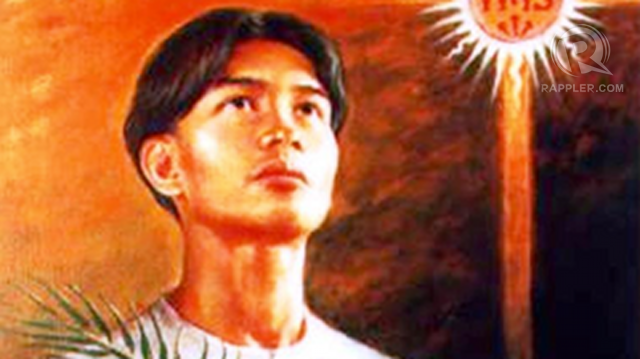SUMMARY
This is AI generated summarization, which may have errors. For context, always refer to the full article.

MANILA, Philippines (UPDATED) – What exactly happened at 4 pm on Sunday, October 21, when Pope Benedict XVI declared Pedro Calungsod, a 17th-century Visayan martyr, the second Filipino saint?
To explain the canonization rites that elevated Calungsod to sainthood, Rappler has compiled frequently-asked-questions about the process of declaring a saint.
What is canonization?
Canonization is the process by which the Pope includes a person in the canon, or catalogue, of Catholic saints. It is the product of years or decades of intense scrutiny, which determines if a candidate has indeed lived a virtuous life and is now in heaven. A major miracle is also required to confirm a person’s sainthood.
Based on the Catechism of the Catholic Church, canonization does not make a person worthy of worship, which Catholics reserve only for God.
“By canonizing some of the faithful, i.e., by solemnly proclaiming that they practiced heroic virtue and lived in fidelity to God’s grace, the Church recognizes the power of the Spirit of holiness within her and sustains the hope of believers by proposing the saints to them as models and intercessors,” the Catechism explains.
Canonization also means the saint’s help may be sought in liturgy, or official prayers, throughout the entire Church.
Why Calungsod called ‘blessed’?
A major step before canonization is to declare a person “blessed.” This is done through beatification, which, like canonization, declares that a person lived in virtue. In beatification, no miracle is required for martyrs like Calungsod, who died due to religious persecution on April 2, 1672.
A major difference is that a beatified person is proposed for veneration, or inclusion in the Church’s official prayers, within a limited area like the person’s locality. In Calungsod’s case, he is widely venerated in the Archdiocese of Cebu, which was once a smaller diocese to which Calungsod belonged.
It is not necessary that the Pope preside over a beatification ceremony.
What will happen during Calungsod’s canonization?
The Pope declared the new saints before a Mass, which is considered the highest form of Catholic prayer. This was unlike in previous canonization rituals, when the Pope declared the new saints within the Mass itself.
The rite began with a greeting by the Pope, followed by a petition by the Prefect of the Congregation of Saints. The prefect approached the Pope to proceed with the candidates’ canonization. He then read a short biography of each.
A prayer and litany followed this. Then the Pope pronounced the official formula of canonization:
“In honor of the Holy Trinity, for the glory of the Catholic faith and the development of the Christian life, with the authority of Our Lord Jesus Christ, of the Holy Apostles Peter and Paul and of Ourself, after long reflection, invoked divine assistance many times and listened to the opinion of many of our Fathers in the Episcopate (Bishops) declare and define as Saints the Blessed… (the Pope reads the candidates’ names)… and inscribe their names in the Canon (List) of the Saints and establish that throughout the Church they be honored devoutly among all the saints.
“In the name of the Father and of the Son and of the Holy Spirit.”
The public responded with a sung “Amen,” and assigned delegates brought to the altar the new saints’ relics. A few more minor rituals followed
Then a Mass took place.
How long did it take for Calungsod to be declared a saint?
While Calungsod died 340 years ago, he surfaced in recent memory only in 1985. That was when his martyred superior, Diego Luis de San Vitores, was declared a blessed. Calungsod’s life was rediscovered through documents submitted for San Vitores’ beatification, because various manuscripts narrated their deaths together.
The Archdiocese of Cebu began to process his beatification only on November 21, 1994, according to a primer prepared by the archdiocese’s Msgr Ildebrando Leyson, who actively pushed for Calungsod’s canonization. The local church concluded its inquiry on December 28, 1994, and turned over its findings to the Vatican.
The Vatican recognized the diocesan process as valid on March 21, 1997. Later, Vatican historians and theologians voted on the authenticity of related documents. This led to Calungsod’s beatification on January 27, 2000. No miracle was required for beatification since Calungsod was a martyr.
The process for his canonization gained momentum in 2003, when a miracle was attributed to Calungsod’s intercession.
“For the Pope to decide for the canonization, he needs a divine sign of approval which we call a miracle. A miracle may be defined as an extraordinary religious occurrence that came about through a special and gratuitous intervention of God. It is contemporaneously a sign or a manifestation of a divine message to man and a call to conversion,” Leyson explained.
“A miracle is a supernatural occurrence, and so, it cannot be explained naturally or scientifically. A major miracle is required for the canonization,” he added. – Rappler.com
Sources: Catechism of the Catholic Church, Msgr Ildebrando Leyson’s Catechetical Primer on Calungsod, Catholic News Service, www.marymackillop.org.au
For more, read:
Add a comment
How does this make you feel?
There are no comments yet. Add your comment to start the conversation.